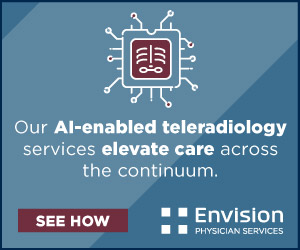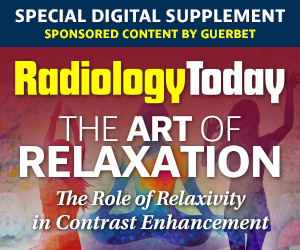|
E-Newsletter • December 2022 |
▼ ADVERTISEMENT

Editor's E-Note
MRI has many advantages, but a significant drawback is the time it takes to run an exam. In this month's issue, we're highlighting work by a researcher at the University of Colorado whose efforts may help reduce MR scan times by as much as 25%, potentially expanding the clinical uses of the modality.
Enjoy the newsletter. Please let us know what you think about it on Twitter and/or Facebook. And from all of us at Radiology Today, we wish you a happy and peaceful holiday season.
— Dave Yeager, editor |
|
|
|
▼ ADVERTISEMENT
 |
Novel Technology Designed to Increase MRI Speeds
Nicholas Dwork, PhD, an assistant professor in the department of biomedical informatics at the University of Colorado School of Medicine, has filed a provisional patent for a technology that could increase scan speeds of 3D MRI. The invention could lead to faster results, increase the clinical applications of MRIs, and ultimately improve patient care.
Complex mathematics and engineering are involved in generating images of internal organs and tissues when patients enter the magnetic tube of an MRI machine. Any movement by the patient can corrupt the images, and the scan can take an hour or longer. During this time, the machine makes loud noises as radio waves reverberate off bodily structures to create images. Because the field of view—the part of space that is imaged—is typically rectangular, the radio waves also bounce off areas outside the body. This is where Dwork’s technology comes into play.
“Suppose you knew nothing at all about the image you were trying to make,” Dwork says. “In that case, you would need a maximum amount of information in order to make the image, which means collecting a maximum amount of data. How can we reduce the amount of data we need? If we had more information about the picture we were making, then we wouldn't need as much data.”
▼ ADVERTISEMENT
 |
▼ ADVERTISEMENT

Radiologists Devise Cost-Effective Coronary Artery Disease Testing Method
An international clinical trial of coronary artery disease showed that a newer, noninvasive testing method performed better and cost less than traditional testing.
Largest Brain Tumor Study to Date Augmented by AI
Thanks to the help of AI, researchers at Penn Medicine were able to aggregate data from over 6,000 brain scans to develop a tumor identification tool that makes tumor boundaries easier to predict.
Photoacoustic Microscopy Provides Advanced Imaging Options
Photoacoustic microscopy, or PAM, is a newer imaging technique that boasts a greater depth of field than previous iterations of the technology. It can image a variety of internal structures, detect changes in blood flow, and identify individual cancer cells.
|
▼ ADVERTISEMENT

“Our deep learning model offers a potential solution for population-based opportunistic screening of cardiovascular disease risk using existing chest X-ray images. This type of screening could be used to identify individuals who would benefit from statin medication but are currently untreated. ... Based on a single existing chest X-ray image, our deep learning model predicts future major adverse cardiovascular events with similar performance and incremental value to the established clinical standard."
— Jakob Weiss, MD, of the Cardiovascular Imaging Research Center at Massachusetts General Hospital, and lead author of a study regarding a new deep learning model that predicts risk of death from atherosclerotic cardiovascular disease
▼ ADVERTISEMENT
 |
|
|
COVER STORY
No Hocus Pocus
With radiologist shortages at an all-time high, point-of-care ultrasound is poised to facilitate faster diagnoses, potentially preventing additional burdens on radiology departments.
FEATURE
Reading the Audience
Interactive radiology reports may help patients understand their medical conditions better, but can they be crafted to avoid radiologist burnout?
|
|
▼ ADVERTISEMENT
 |
| Advertising Opportunities |
Have a product or service you want to market to radiology professionals? Utilize the reach of Radiology Today Magazine to accomplish your marketing goals. Email our experienced account executives today at sales@gvpub.com or call 800-278-4400 for more information.
|
| © 2022 Radiology Today Magazine |
|
|